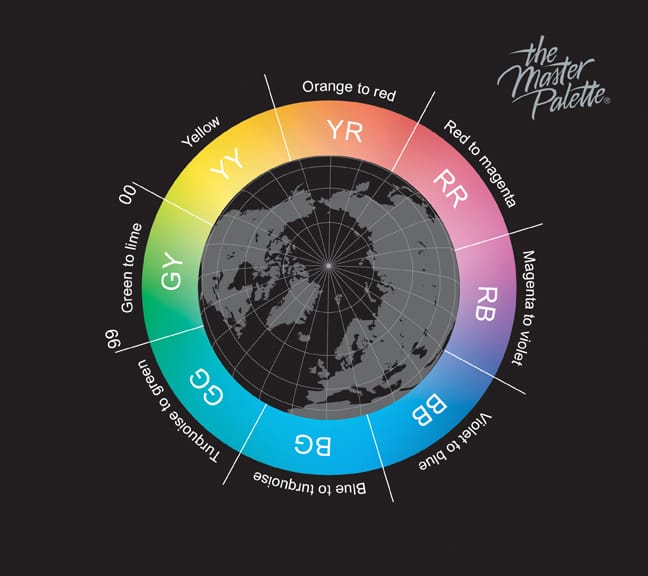We have already started to learn How To Use The Master Palette. It’s time to dig deeper into the hue family structure of The Master Palette. Because before we move on to other parts of the notation that include LRV and chroma, I want to be sure you understand hue families, hue bias, and overtones. As a reminder, the color notation is outlined in hot pink below. We’re still talking about the two-letter hue family designation and have not yet moved on to the numbers on the back end.
Here’s The Master Palette Color Wheel you need to decode the two-letter hue family in the notation. In the example above it’s GY. An abbreviation for Green-Yellow.

A review of the Components of Color

Hue
Defines the color of color family. Red, Yellow and Blue represent the basic color families to which a given shade can be assigned. The outer band shows the hue circuit.
Value
Describes the lightness or darkness of a color. The lighter the color, the more light it reflects. The central axis (column) presents a gradient of greys between the colors of white, at the top, and black towards the bottom.
Chroma
Describes the intensity or saturation of a color. Strong colors like “Racy Red” have a high chroma factor while soft shades like “Muted Rose” have a low level of chroma. The degree of chroma progressively lessens, as you move from the outer band to the central axis.
Changing any one of these three dimensions creates the vast array of color in the Master Palette. What is the Master Palette Notation?
The Master Palette Notation can tell us at a glance what a color is and how it differs from other colors. It is calculated using our propietary technology and scientific principles to define the position of a color in color space. Using this methodology, a Master Palette Notation can be generated for any color.

50BB represents the Hue or Color Family. Each Hue Family has five sections (10, 30, 50, 70 and 90), with the exception of the YY and YR families, which have 10 and 7 sections respectively. This is because these areas have more segments and pages due to the popularity of their colors.
The following list features the color areas within the Master Palette:
| RR = Magenta to Red YR = Red to Orange YY = Orange to Yellow to Lime | GY = Lime to Green GG = Green to Turquoise BG = Turquoise to Blue | BB = Blue to Violet RB = Violet to Magenta NN = Neutral |
The two digit number of 11 represents the Light Reflectance Value of the color. The Master Palette LRV scale is 00-99. The higher the number, the more light a color reflects. A lower LRV number means the color will absorb more of the light that hits it and reflect a lesser proportion back into the space.
The last three digits of 321 represent the Chroma or Intensity of the color on a scale of 000-999. The higher the number, the more intense, strong, clean and colorful the color. Conversely, a lower number indicates a weaker, dirtier, less colorful color.
